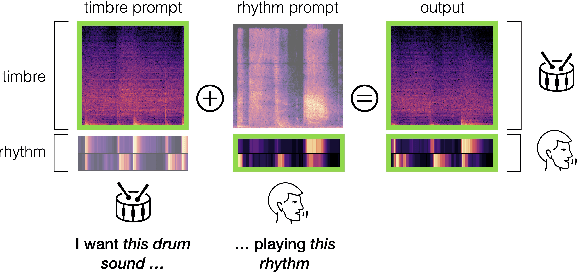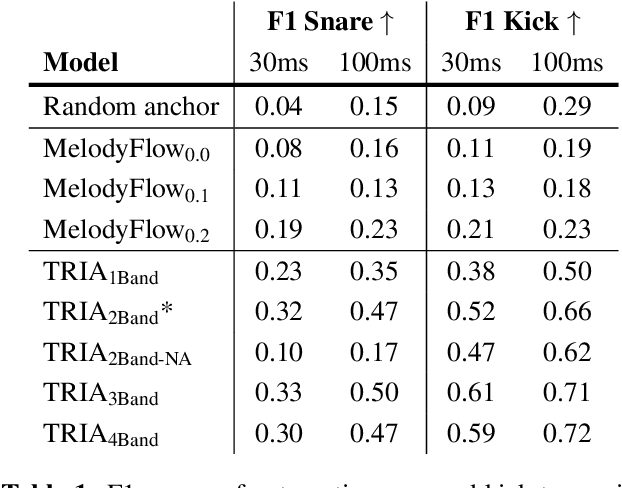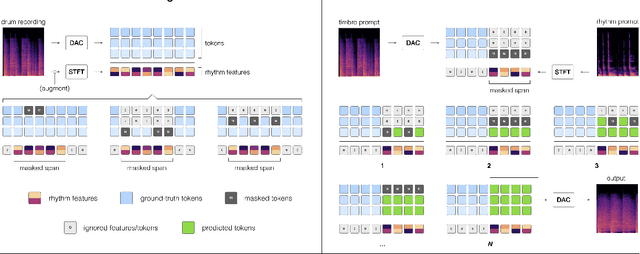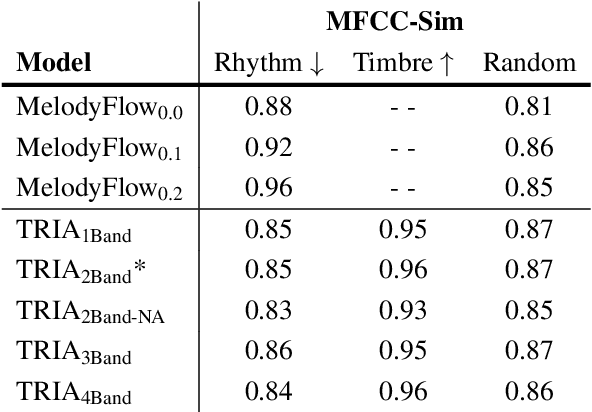music generation
Music generation is the task of generating music or music-like sounds from a model or algorithm.
Papers and Code
MelCap: A Unified Single-Codebook Neural Codec for High-Fidelity Audio Compression
Oct 02, 2025Neural audio codecs have recently emerged as powerful tools for high-quality and low-bitrate audio compression, leveraging deep generative models to learn latent representations of audio signals. However, existing approaches either rely on a single quantizer that only processes speech domain, or on multiple quantizers that are not well suited for downstream tasks. To address this issue, we propose MelCap, a unified "one-codebook-for-all" neural codec that effectively handles speech, music, and general sound. By decomposing audio reconstruction into two stages, our method preserves more acoustic details than previous single-codebook approaches, while achieving performance comparable to mainstream multi-codebook methods. In the first stage, audio is transformed into mel-spectrograms, which are compressed and quantized into compact single tokens using a 2D tokenizer. A perceptual loss is further applied to mitigate the over-smoothing artifacts observed in spectrogram reconstruction. In the second stage, a Vocoder recovers waveforms from the mel discrete tokens in a single forward pass, enabling real-time decoding. Both objective and subjective evaluations demonstrate that MelCap achieves quality on comparable to state-of-the-art multi-codebook codecs, while retaining the computational simplicity of a single-codebook design, thereby providing an effective representation for downstream tasks.
High-Quality Sound Separation Across Diverse Categories via Visually-Guided Generative Modeling
Sep 26, 2025We propose DAVIS, a Diffusion-based Audio-VIsual Separation framework that solves the audio-visual sound source separation task through generative learning. Existing methods typically frame sound separation as a mask-based regression problem, achieving significant progress. However, they face limitations in capturing the complex data distribution required for high-quality separation of sounds from diverse categories. In contrast, DAVIS circumvents these issues by leveraging potent generative modeling paradigms, specifically Denoising Diffusion Probabilistic Models (DDPM) and the more recent Flow Matching (FM), integrated within a specialized Separation U-Net architecture. Our framework operates by synthesizing the desired separated sound spectrograms directly from a noise distribution, conditioned concurrently on the mixed audio input and associated visual information. The inherent nature of its generative objective makes DAVIS particularly adept at producing high-quality sound separations for diverse sound categories. We present comparative evaluations of DAVIS, encompassing both its DDPM and Flow Matching variants, against leading methods on the standard AVE and MUSIC datasets. The results affirm that both variants surpass existing approaches in separation quality, highlighting the efficacy of our generative framework for tackling the audio-visual source separation task.
AnyAccomp: Generalizable Accompaniment Generation via Quantized Melodic Bottleneck
Sep 17, 2025Singing Accompaniment Generation (SAG) is the process of generating instrumental music for a given clean vocal input. However, existing SAG techniques use source-separated vocals as input and overfit to separation artifacts. This creates a critical train-test mismatch, leading to failure on clean, real-world vocal inputs. We introduce AnyAccomp, a framework that resolves this by decoupling accompaniment generation from source-dependent artifacts. AnyAccomp first employs a quantized melodic bottleneck, using a chromagram and a VQ-VAE to extract a discrete and timbre-invariant representation of the core melody. A subsequent flow-matching model then generates the accompaniment conditioned on these robust codes. Experiments show AnyAccomp achieves competitive performance on separated-vocal benchmarks while significantly outperforming baselines on generalization test sets of clean studio vocals and, notably, solo instrumental tracks. This demonstrates a qualitative leap in generalization, enabling robust accompaniment for instruments - a task where existing models completely fail - and paving the way for more versatile music co-creation tools. Demo audio and code: https://anyaccomp.github.io
Jamendo-QA: A Large-Scale Music Question Answering Dataset
Sep 19, 2025We introduce Jamendo-QA, a large-scale dataset for Music Question Answering (Music-QA). The dataset is built on freely licensed tracks from the Jamendo platform and is automatically annotated using the Qwen-Omni model. Jamendo-QA provides question-answer pairs and captions aligned with music audio, enabling both supervised training and zero-shot evaluation. Our resource aims to fill the gap of music-specific QA datasets and foster further research in music understanding, retrieval, and generative applications. In addition to its scale, Jamendo-QA covers a diverse range of genres, instruments, and metadata attributes, allowing robust model benchmarking across varied musical contexts. We also provide detailed dataset statistics and highlight potential biases such as genre and gender imbalance to guide fair evaluation. We position Jamendo-QA as a scalable and publicly available benchmark that can facilitate future research in music understanding, multimodal modeling, and fair evaluation of music-oriented QA systems.
Continuous Audio Language Models
Sep 09, 2025Audio Language Models (ALM) have emerged as the dominant paradigm for speech and music generation by representing audio as sequences of discrete tokens. Yet, unlike text tokens, which are invertible, audio tokens are extracted from lossy codecs with a limited bitrate. As a consequence, increasing audio quality requires generating more tokens, which imposes a trade-off between fidelity and computational cost. We address this issue by studying Continuous Audio Language Models (CALM). These models instantiate a large Transformer backbone that produces a contextual embedding at every timestep. This sequential information then conditions an MLP that generates the next continuous frame of an audio VAE through consistency modeling. By avoiding lossy compression, CALM achieves higher quality at lower computational cost than their discrete counterpart. Experiments on speech and music demonstrate improved efficiency and fidelity over state-of-the-art discrete audio language models, facilitating lightweight, high-quality audio generation. Samples are available at hf.co/spaces/kyutai/calm-samples
Contrastive timbre representations for musical instrument and synthesizer retrieval
Sep 16, 2025Efficiently retrieving specific instrument timbres from audio mixtures remains a challenge in digital music production. This paper introduces a contrastive learning framework for musical instrument retrieval, enabling direct querying of instrument databases using a single model for both single- and multi-instrument sounds. We propose techniques to generate realistic positive/negative pairs of sounds for virtual musical instruments, such as samplers and synthesizers, addressing limitations in common audio data augmentation methods. The first experiment focuses on instrument retrieval from a dataset of 3,884 instruments, using single-instrument audio as input. Contrastive approaches are competitive with previous works based on classification pre-training. The second experiment considers multi-instrument retrieval with a mixture of instruments as audio input. In this case, the proposed contrastive framework outperforms related works, achieving 81.7\% top-1 and 95.7\% top-5 accuracies for three-instrument mixtures.
Real-world Music Plagiarism Detection With Music Segment Transcription System
Sep 10, 2025As a result of continuous advances in Music Information Retrieval (MIR) technology, generating and distributing music has become more diverse and accessible. In this context, interest in music intellectual property protection is increasing to safeguard individual music copyrights. In this work, we propose a system for detecting music plagiarism by combining various MIR technologies. We developed a music segment transcription system that extracts musically meaningful segments from audio recordings to detect plagiarism across different musical formats. With this system, we compute similarity scores based on multiple musical features that can be evaluated through comprehensive musical analysis. Our approach demonstrated promising results in music plagiarism detection experiments, and the proposed method can be applied to real-world music scenarios. We also collected a Similar Music Pair (SMP) dataset for musical similarity research using real-world cases. The dataset are publicly available.
Back to Ear: Perceptually Driven High Fidelity Music Reconstruction
Sep 18, 2025Variational Autoencoders (VAEs) are essential for large-scale audio tasks like diffusion-based generation. However, existing open-source models often neglect auditory perceptual aspects during training, leading to weaknesses in phase accuracy and stereophonic spatial representation. To address these challenges, we propose {\epsilon}ar-VAE, an open-source music signal reconstruction model that rethinks and optimizes the VAE training paradigm. Our contributions are threefold: (i) A K-weighting perceptual filter applied prior to loss calculation to align the objective with auditory perception. (ii) Two novel phase losses: a Correlation Loss for stereo coherence, and a Phase Loss using its derivatives--Instantaneous Frequency and Group Delay--for precision. (iii) A new spectral supervision paradigm where magnitude is supervised by all four Mid/Side/Left/Right components, while phase is supervised only by the LR components. Experiments show {\epsilon}ar-VAE at 44.1kHz substantially outperforms leading open-source models across diverse metrics, showing particular strength in reconstructing high-frequency harmonics and the spatial characteristics.
The Rhythm In Anything: Audio-Prompted Drums Generation with Masked Language Modeling
Sep 19, 2025



Musicians and nonmusicians alike use rhythmic sound gestures, such as tapping and beatboxing, to express drum patterns. While these gestures effectively communicate musical ideas, realizing these ideas as fully-produced drum recordings can be time-consuming, potentially disrupting many creative workflows. To bridge this gap, we present TRIA (The Rhythm In Anything), a masked transformer model for mapping rhythmic sound gestures to high-fidelity drum recordings. Given an audio prompt of the desired rhythmic pattern and a second prompt to represent drumkit timbre, TRIA produces audio of a drumkit playing the desired rhythm (with appropriate elaborations) in the desired timbre. Subjective and objective evaluations show that a TRIA model trained on less than 10 hours of publicly-available drum data can generate high-quality, faithful realizations of sound gestures across a wide range of timbres in a zero-shot manner.
TISDiSS: A Training-Time and Inference-Time Scalable Framework for Discriminative Source Separation
Sep 19, 2025Source separation is a fundamental task in speech, music, and audio processing, and it also provides cleaner and larger data for training generative models. However, improving separation performance in practice often depends on increasingly large networks, inflating training and deployment costs. Motivated by recent advances in inference-time scaling for generative modeling, we propose Training-Time and Inference-Time Scalable Discriminative Source Separation (TISDiSS), a unified framework that integrates early-split multi-loss supervision, shared-parameter design, and dynamic inference repetitions. TISDiSS enables flexible speed-performance trade-offs by adjusting inference depth without retraining additional models. We further provide systematic analyses of architectural and training choices and show that training with more inference repetitions improves shallow-inference performance, benefiting low-latency applications. Experiments on standard speech separation benchmarks demonstrate state-of-the-art performance with a reduced parameter count, establishing TISDiSS as a scalable and practical framework for adaptive source separation.
 Add to Chrome
Add to Chrome Add to Firefox
Add to Firefox Add to Edge
Add to Edge